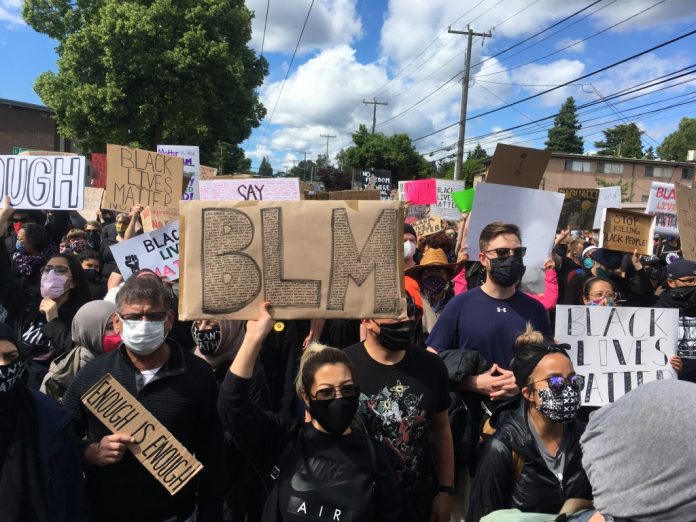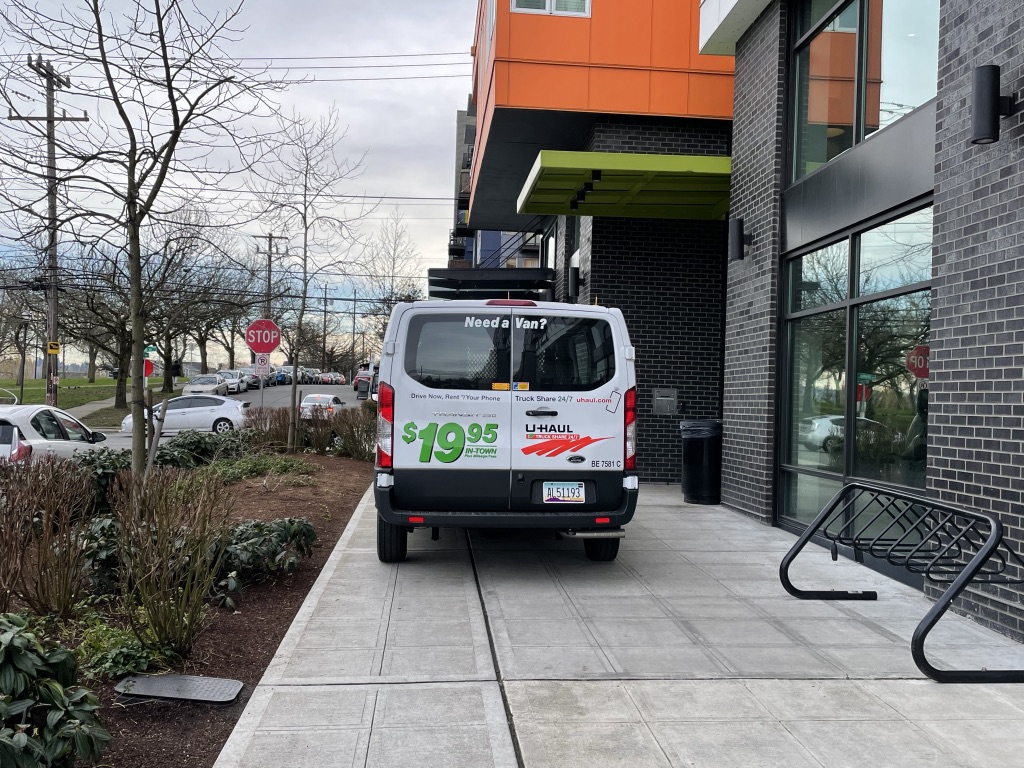While much of the media may have convinced itself that Seattle City Council radically defunded the police, it didn’t. What Council did do was make some tweaks around the edges and engage in some budgetary magic to reduce the police budget while maintaining public safety spending overall in other guises. The primary way it did this was by moving the 911 dispatch to the new “Community Safety and Communications Center” and by moving the parking enforcement division to the Seattle Department of Transportation (SDOT) as a downpayment on a less punitive system of public safety. After that, efforts seemed to have lost steam.
Now in Mayor Bruce Harrell’s 2023-2024 budget, he proposes to undo half of this work by moving parking enforcement back to the Seattle Police Department (SPD). This reversal is a bad idea and the City Council should overrule him. Here are a few reasons why parking enforcement should remain outside SPD:
Don’t Reward Negligence
The mayor’s justification for reversing the transfer is that it will save approximately five million dollars in administrative costs required to complete it and house these officers in SDOT. Ironically, SPD lost at least that amount of money due to refunded parking tickets when it botched the transition, failing to complete paperwork to authorizing parking enforcement to continue issuing tickets despite being asked to do so. (Another parting gift of a failed Durkan administration.) This blew a bigger hole in the City budget than reversing the move now allegedly “saves.”
Why reward a department for such obstruction and negligence? At the very least, the Harrell administration needs to demonstrate the nature of the cost savings and why SDOT’s overhead costs would be much higher than SPD’s. Does SPD just have that many extra resources lying around going unused?
Political Tricks Aren’t the Basis of Good Policy
My suspicion is that Harrell is reversing the transfer as a budget trick to make it look like he refunded a defunded police, when in reality SPD was never defunded and he didn’t do anything but move money that would have been budgeted under SDOT to SPD. Harrell’s been happily funding vacant police officer positions that the City has no chance of filling given the nationwide police shortage to goose the budget numbers, and this would be even better.
A quick internet search reveals plenty of stories about how the mayor’s budget increases police funding, but when you read beyond the headlines the majority of the increase results from parking enforcement’s move. Mission accomplished. Of course the problem now will be if the City Council stops the retransfer, we all know what those headlines will be. If nothing else the mayor is good at the game of politics.
Beyond stopping what is likely a purely cynical political ploy by the mayor, the move would undercut real positives of having parking enforcement out from under the armed umbrella of SPD.
Thousands Protested on Our Streets for Months for Change
Seattle had a year of upheaval and self-reflection brought about by the Black Lives Matter (BLM) movement, the biggest civil rights action to occur during many of our lifetimes, one that was long overdue in a nation that has struggled to honestly face the sins of our past and how they continue to play out today. Thousands of people marched in the streets and examined their personal role in supporting a racist system, while politicians pledged to make up for the wrongs of the past and work for a better tomorrow.
One strong current of change was the call to civilianize what have historically been police duties. In Seattle, it seemed the transition was going to start with parking enforcement and 911 dispatch and then move into the many other areas where armed police are not required. Mayor Durkan started Triage One as a proto third public safety agency (in addition to police and fire) and appeared to be studying how to expand it.
It was easy to see how we get the cops out of Parking Enforcement (giving tickets to stationary vehicles) today and then envision a similar move for Traffic Enforcement (moving violations) tomorrow. This second move is especially important because so many of the fatal encounters that galvanized the BLM movement started as routine traffic stops: Sandra Bland, Philando Castile, and far too many others. It’s also an idea that even Mayor Harrell and his some of chief advisors have spoken positively about in the past and have been studying.
But then the backlash happened. With the help of right-wing talking heads, BLM went from an idea that almost no one could object to (because how can you?), to the cause of any urban ill, from a spike in the murder rate, to graffiti and retail vacancies.
The national reflection on our racial dynamic as been subsumed by the shrill voices of the conspiratorial right and their fear that “critical race theory” may cause their White children to feel a tinge of guilt while reading about the enslavement of millions of Africans or the genocidal treatment of Indigenous people. It seems even in liberal Seattle, where the no one can outwardly object to the ideas of BLM, many politicians (and including some who had pledged to make real change) seem willing to undo the few tangible victories achieved and abandon the visions of alternatives to armed law enforcement being our only response to any crisis.
And before you say that Harrell has been working with the City Council on police alternatives (they even released a term sheet!) the slow pace of their process makes one wonder if this is a serious idea or another example of Seattle smothering progressive change with it well-known endless process.
Maintaining parking enforcement within SDOT keeps the door open to a different version of public safety, one that involves fewer people with guns and more appropriate and measured responses to everything from a car blocking a crosswalk to someone in mental distress on a Downtown street corner.
This Could Be the Opening to Changing How Traffic Enforcement Supports Vision Zero
Despite Seattle’s Vision Zero commitment to ending traffic deaths, as The Urbanist has covered endlessly, our city remains far from that goal. Cars still drive too fast, in too many places, and our sidewalk and bike networks are incomplete and often have cars blocking them. Well, what if instead of making sure cars didn’t overstay their meters, parking enforcement officials also more consistently expanded its focus to the dangers posed to our most vulnerable road users? What if they spent more time proactively ticketing people blocking sidewalks and bike lanes?
While the preferred solution to dangerous driving is to redesign our streets around the safety of non-drivers, the fact that City has failed to deliver to all residents the most basic service of sidewalks make me think it will be a while before all our roads are rebuilt. The next best option for making streets safer is camera enforcement — cameras aren’t racist, don’t profile, and don’t escalate a ticket to a dangerous encounter. Progressively-scaled fines could ensure Seattle’s wealthier residents still feel a deterrent and fines don’t fall too heavily on the poor.
As Ryan Packer points out, Seattle currently has the ability to add camera enforcement in more locations but hasn’t. The city should use its camera authority everywhere permitted and the state should allow the expansion of their use, which it currently limits. In the meantime, some level of traffic enforcement will be needed to get drivers to act safer. Using armed police is not an option.
What if traffic enforcement was also taken out of SPD (as recommended by Whose Streets? Our Streets!) and moved to SDOT to likewise employ unarmed civilians enforcement? While some would counter that having unarmed civilians engaging in traffic stops would be risky for these city workers’ welfare, evidence indicates that the risks for police associated with these encounters has been overblown.
A 2019 study published by the Michigan Law Review that examined violence in routine traffic stops against officers in 200 Florida police departments over a 10-year period found “that violence against officers was rare and that incidents that do involve violence are typically low risk and do not involve weapons.”
Under a conservative estimate, the rate for a felonious killing of an officer during a routine traffic stop was only 1 in every 6.5 million stops, the rate for an assault resulting in serious injury to an officer was only 1 in every 361,111 stops, and the rate for an assault against officers (whether it results in injury or not) was only 1 in every 6,959 stops.
Jordan B. Woods, Policing, Danger Narratives, and Routine Traffic Stops, 117 Mich. L. Rev. 635 (2019)
At the same time, the threats posed by traffic violence do present a risk to officers’s safety, just as they do to all road users, including the most vulnerable pedestrians and cyclists.
“I worry more about getting hit by a car on a traffic call than I do getting shot,” Sergeant Dave Lawler of the Linn County (OR) Sheriff’s Office told Police Magazine in an article on the hazards of traffic stops.
In addition to decreasing the risk of a routine traffic stop escalating to violence, there would be other benefits to civilianizing traffic enforcement under SDOT as well. Many police officers see the city mostly from their windshield, on their commute into the city from their suburban homes and from their cruisers as they speed down our streets. For all its flaws, SDOT is an agency filled with employees who are committed to Vision Zero and to making walking, transit, and biking safer and easier. Having traffic enforcement rooted in that perspective and focused on actions that would make our streets safer from traffic violence would be a great step forward.
It’s Time for the City Council to Remember Its Commitments
A majority of the City Council voted to move parking enforcement out of SPD in two years ago — Lisa Herbold, Tammy Morales, Kshama Sawant, Debora Juarez, Dan Strauss, Andrew Lewis, and Teresa Mosqueda. These councilmembers were a majority of the council at the time and they are a majority now. In the time since, SPD has not been not been fixed or reformed. Extremist Mike Solan, known for his podcast Hold the Line, is still head of the Seattle Police Guild Union and Adrian Diaz, an SPD lifer, is now Chief of Police. America has not fixed our civil rights issues and Black lives still do matter. So the same councilmembers who voted to civilianize parking enforcement should reject the mayor’s proposal and instead continue to explore options for a non-police public safety system. It can happen, here in Seattle, and now.
Patrick grew up across the Puget Sound from Seattle and used to skip school to come hang out in the city. He is an designer at a small architecture firm with a strong focus on urban infill housing. He is passionate about design, housing affordability, biking, and what makes cities so magical. He works to advocate for abundant and diverse housing options and for a city that is a joy for people on bikes and foot. He and his family live in the Othello neighborhood.



